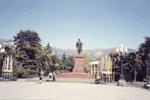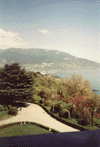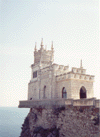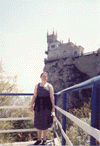Travel Bug’s Ukrainian Photo Gallery
Below are thumbnails of selected scenes from life and
journeys in several cities in
Kharkiv (Kharkov) Kyiv (Kiev) Chernihiv (Chernigov) Odesa (Odessa)
Notes:
- Click on the thumbnail to get the larger
picture.
- Use the “back” button on your browser to return
to this page.
- I’m using the Ukrainian names of each town. If the town has a different Russian name
(which might be better known by locals, former residents, ancestors, etc.)
I have put that in parentheses.
- If you want more detailed information on these
cities, or links to other Ukrainian sites, please visit my Life and Travels in
Ukraine page.
![]()
Kharkiv
(Kharkov
This town, which I lived in for one year, is the second
largest city in
 Me in front
of the Lenin Statue,
Me in front
of the Lenin Statue, 
Monument
to 10 years of Ukrainian Independence 
Monument
to national poet Taras Shevchenko 
Kharkiv
Centralny Rynok (Kharkiv
central market) 

Blahoveshchensky Cathedral  October
Revolution Day, November 9
October
Revolution Day, November 9 
Kharkiv
in fall  Kharkiv's first
snow, October 2001
Kharkiv's first
snow, October 2001 
Me
on a December day in my Ukrainian coat and boots 
Digging
up ice to find the sidewalk, January 2002  Winter
splendor, March 2002
Winter
splendor, March 2002 
![]()
Kyiv (Kiev
Geographically, Kyiv is the center of Ukraine. Politically, it is where Ukraine was born and where politicians continue to live and wreak havoc on Ukrainian life. It is very beautiful, historic, and cosmopolitan from an ex-pat point of view. A definite must-see if you are in Ukraine.
View of Kyiv and the Dnipro from the Pechersky Lavra 
Recently restored cathedral inside
the monastery grounds 
 Me,
Me, 
Andrisky Uzviz
(arts and crafts street near 
Chernihiv (Chernigov)
Chernihiv is one of the oldest cities in Ukraine, and is a lovely town a mere two hours north of Kyiv by minibus. The students who gave us a tour of the city said that angels watch over the city and protected it from the radiation of nearby Chornobyl. I’m inclined to believe them.
Cathedral in Chernihiv  Me and the cannons
Me and the cannons 
![]()
Odesa (Odessa)
One of the more famous places in Ukraine (though perhaps thought of as more Russian than Ukrainian), it’s a lovely seaside town with great restaurants and beaches. Unfortunately, it’s also the capital of the Ukrainian Mafia. But not to worry, if you are a regular Joe or Joanna, it’s safe to come by and see the sights. A must see are the Potemkin steps, made famous in the movie “The Battleship Potemkin”.
The Potemkin
Steps  View of the
View of the 
Interior of the 

![]()
Crimea
The Crimean Peninsula is a major resort area for Ukraine. Khrushchev gave the peninsula to the Ukrainian SSR as a gift in the 50s. Now Russians need a visa to visit it. And Crimeans themselves (other than the returning Tartars) wish they were part of Russia, not Ukraine. One look at the pictures and you’ll know why Ukraine would never give this area back to Russia.

Greek Ruins of Khersoneus,


Lenin statue and Naberezhna
Lenina, 

Chekhov House, 




View of 
![]()
Lviv (Lvov)
I like to call Lviv the capital of Western Ukraine. It used to be part of the Austro-Hungarian Empire, then part of Poland. The region tends to be more nationalistic, though Lviv residents are more willing to speak Russian than residents of other western towns where only Ukrainian language is acceptable. The city feels more European than any city in Ukraine that I have been in to date.
This section is dedicated to the memories of those who lost their lives in the air show disaster on July 27, 2002.
View
of Lviv from Highcastle
(not an actual castle, just a high lookout point) 
Lviv Opera House  Lviv Rynok (Bazaar—most beautiful in
Lviv Rynok (Bazaar—most beautiful in 
Kazatin
This town, less than 3 hours south of Kyiv, is where my great-grandfather grew up. When my great-grandfather lived here the town was a major north-south east-west railroad junction. It still is today. I can only assume that the town was as poor then as it is now. Many buildings (including the secondary school) do not have indoor plumbing. The horse drawn cart is still a major form of transportation. The city has a WWII memorial that is supposed to have an eternal flame, but the city can’t afford the gas. What has changed is the Jewish presence. I am not sure if the Jews in the city were killed in the pogroms before World War I, or by Hitler’s troops in WWII, or both. I was fortunate to meet one Jew, Sasha, (pictured with me at the cemetery remains) who led me to the alleged site of the old Jewish cemetery. There are no markers any more. Sasha’s grandmother is buried there but he doesn’t know where. There is no synagogue or any other sign of Jewish life in the city. Nevertheless, when I stood on a path on the way to the cemetery site before I knew that’s what it was, I got a sense of a presence that was perhaps that of my great-grandfather or of his ancestors.
Goat grazing in front of outhouses  Two-horse cart
Two-horse cart 
Town river (no name) WWII Memorial
WWII Memorial 
Train station—symbol, entrance, and
platform 











